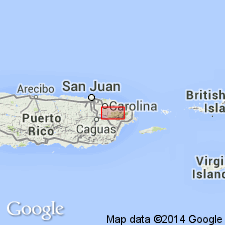
- Usage in publication:
-
- Celada Formation*
- Modifications:
-
- Named
- Dominant lithology:
-
- Lava
- Basalt
- Breccia
- AAPG geologic province:
-
- Caribbean region
Summary:
The Celada Formation, here named, consists of basaltic pillow lavas and breccias in southwest Gurabo quadrangle. Conformably overlies the Infierno Formation; top is cut out by faults. Thickness is more than 600 m. Age is Late Cretaceous (Turonian to Santonian) based on correlation with the lower Canovanas Formation.
Source: GNU records (USGS DDS-6; Reston GNULEX).

- Usage in publication:
-
- Celada Formation*
- Modifications:
-
- Overview
- AAPG geologic province:
-
- Caribbean region
Summary:
The Celada Formation occurs in eastern Puerto Rico and consists of pillowed basaltic lava flows and hyaloclastite breccia, volcanic breccia, and pumiceous volcanic sandstone and mudstone. Flows are identical to those in the Infierno Formation. Maximum estimated thickness is 600 meters. The Celada is of Late Cretaceous age.
Source: GNU records (USGS DDS-6; Reston GNULEX).
For more information, please contact Nancy Stamm, Geologic Names Committee Secretary.
Asterisk (*) indicates published by U.S. Geological Survey authors.
"No current usage" (†) implies that a name has been abandoned or has fallen into disuse. Former usage and, if known, replacement name given in parentheses ( ).
Slash (/) indicates name conflicts with nomenclatural guidelines (CSN, 1933; ACSN, 1961, 1970; NACSN, 1983, 2005, 2021). May be explained within brackets ([ ]).

